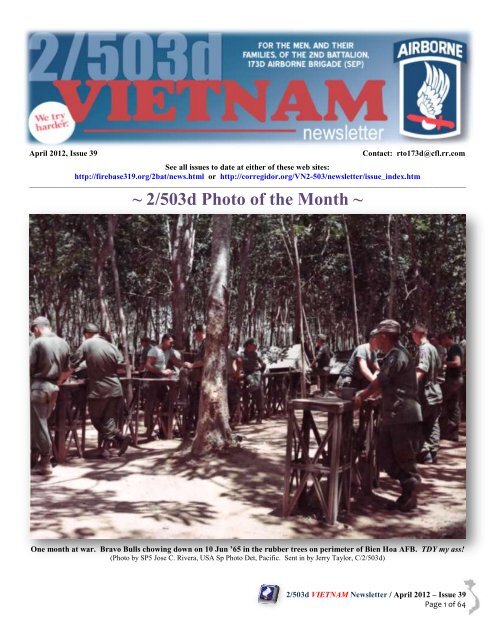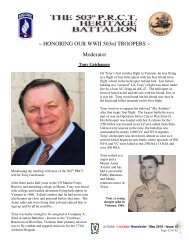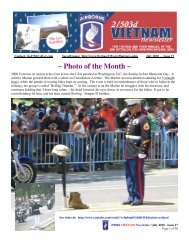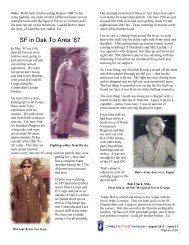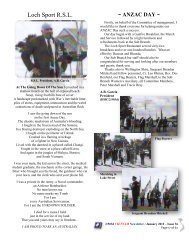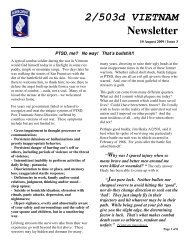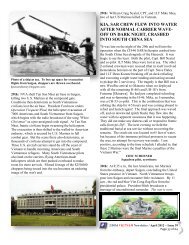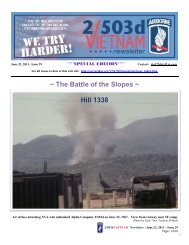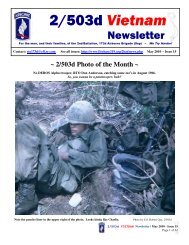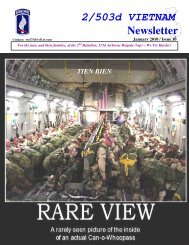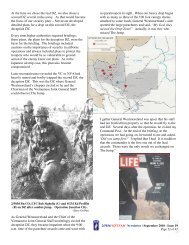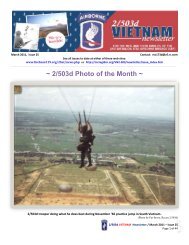Issue 39a - Firebase 319
Issue 39a - Firebase 319
Issue 39a - Firebase 319
Create successful ePaper yourself
Turn your PDF publications into a flip-book with our unique Google optimized e-Paper software.
April 2012, <strong>Issue</strong> 39 Contact: rto173d@cfl.rr.com<br />
See all issues to date at either of these web sites:<br />
http://firebase<strong>319</strong>.org/2bat/news.html or http://corregidor.org/VN2-503/newsletter/issue_index.htm<br />
_______________________________________________________________________________________________________________________________________<br />
~ 2/503d Photo of the Month ~<br />
One month at war. Bravo Bulls chowing down on 10 Jun ’65 in the rubber trees on perimeter of Bien Hoa AFB. TDY my ass!<br />
(Photo by SP5 Jose C. Rivera, USA Sp Photo Det, Pacific. Sent in by Jerry Taylor, C/2/503d)<br />
2/503d VIETNAM Newsletter / April 2012 – <strong>Issue</strong> 39<br />
Page 1 of 64
Chaplain’s<br />
Corner<br />
Cherished Sky Soldiers,<br />
Families and Friends:<br />
Grace and Peace! The Leapin’ Deacon<br />
It has been a blessing to visit with you in the "Chaplain's<br />
Corner" this past year. I say farewell to you with our<br />
treasured Jump Commands. A good part of my 30 plus<br />
years on Active Duty was spent in the Airborne<br />
Community. It was an absolute delight and honor to serve<br />
as Chaplain and Pastor with these highly motivated special<br />
kind of Warriors of our loved Country. Life was packed<br />
with extremely demanding challenges and gifted<br />
opportunities.<br />
The paratroopers did considerable vigorous preparation and<br />
high adventure training to successfully exit a troop-carrying<br />
aircraft flying 1,000 feet above the earth at 150 knots per<br />
hour.<br />
The Jumpmaster calls out eight (8) “Jump Commands” and<br />
uses ‘hand signals’ to direct the eager paratroopers as they<br />
get ready for an Airborne Operation Mission. I prepared a<br />
sermon/message on each of the “Jump Commands” with a<br />
Biblical parallel passage. The paratroopers were in a<br />
LISTENING mode just prior to the jump. The Lord used<br />
this sacred time to win, hold, develop, and disciple our Sky<br />
Troopers.<br />
The First Jump Command: GET READY! There are<br />
several Biblical passages that can be used. St. Luke 12:35-<br />
37 emphasizes “Readiness” to get ready for a deeper and<br />
more sure and meaningful walk with our Lord. This is a<br />
great an ultimate moment! We are ‘ready’ to successfully<br />
exit an aircraft 1,000 feet at 150 knots. (In combat the<br />
paratrooper jumps out at 500-700 feet – so the adversary<br />
cannot take too many shots at them on the way down).<br />
The Second Jump Command: STAND UP! Psalm 27 and<br />
103 herald forth as well as Ephesians 6. Stand up with and<br />
for your Savior and Lord in true high adventure living. The<br />
fully equipped paratrooper with an extra hundred pounds of<br />
gear, ammo, and needed resources for a period of little resupply,<br />
boldly stands up and prepares to do the mission at<br />
hand – to jump on an Airborne Operation. This is the time<br />
to excel and he/she does just that with a deep sense of<br />
accomplishment and courage.<br />
The Third Jump Command: HOOK UP! There are many<br />
Biblical texts, Psalm 23 and 51, St. Luke 9:28, that<br />
underscore our vital communication and life line with our<br />
Lord in Prayer! The paratrooper ‘hooks up’ his parachute<br />
to the strong and heavy cable overhead. The hook up is<br />
like a lifeline.<br />
The Fourth Jump Command: CHECK STATIC LINE!<br />
Years ago I had a tremendous and tough Commander who<br />
deeply cared for all soldiers, and excelled in getting things<br />
done right. One of his key statements was, “Check,<br />
Check, Check!” On this fourth command the paratroopers<br />
would give a vigorous check and pull to assure that all was<br />
hooked up correctly. It was also a time of extreme care for<br />
the paratroopers around you – checking that they are safe<br />
and ready for this mission.<br />
The Fifth Jump Command: CHECK EQUIPMENT!<br />
The Biblical parallels are many, but we will use primarily<br />
Ephesians 6:10-20 – “Put on the full armor of God…stand<br />
firm then, with the belt of truth buckled around your waist,<br />
with the breastplate of righteousness in place and with your<br />
feet fitted with the readiness that comes from the gospel of<br />
peace. In addition to all this, take up the shield of faith,<br />
with which you can extinguish all the flaming arrows of the<br />
evil one. Take the helmet of salvation and the sword of the<br />
Spirit which is the Word of God.”<br />
The Sixth Jump Command: SOUND OFF EQUIPMENT<br />
CHECK! Psalm 107 and I Peter 3-5. All is checked out<br />
and well – you “Sound off” with a loud “OK” as you<br />
sharply slap the rear end of the person in front of you. The<br />
Sky Soldier is ready!<br />
The Seventh Jump Command: STAND IN THE DOOR!<br />
St. John 10:9 “I am the DOOR!” Wow! What a Promise<br />
and Blessing! This is the ultimate moment of our training!<br />
By the open door of the aircraft are two (2) lights, one Red<br />
meaning stop/hold and you know what the Green one<br />
means. In all my many hundreds of jumps, I have never<br />
faced the open ‘Jump Door’ without the abiding and sure<br />
promise in the Word of God – “I am the DOOR!”<br />
The Eighth and final Jump Command: GO! The Green<br />
light is on and out you go. You count to four (4) – one<br />
thousand to four thousand, as your main parachute canopy<br />
opens. What a beautiful and jubilant sight! The Biblical<br />
passage – St. Matthew 28:16-20, the Great Commission,<br />
“Go into all Nations…I am with you ALWAYS!”<br />
We are blessed to be blessings. A most sacred and gracefilled<br />
Lenten Season, Holy Week, Easter, and Passover to<br />
you!<br />
Chaplain Conrad N. Walker, COL, Ret.<br />
“The Leapin’ Deacon”<br />
National Chaplain Emeritus<br />
173d Airborne Association<br />
Military Order of the Purple Heart<br />
- - - - - - - - - - - - - - - - - - - - - - - - - - - - - - - - - -<br />
Dear Connie:<br />
On behalf of all officers and men of the 2/503d, thank you for sharing your<br />
uplifting messages over the past months, but most of all, thank you for being<br />
there for your Sky Soldiers during time of war. All The Way, Sir!<br />
2/503d VIETNAM Newsletter / April 2012 – <strong>Issue</strong> 39<br />
Page 2 of 64
The White House<br />
Office of the Press Secretary<br />
March 29, 2012<br />
Presidential Proclamation -- Vietnam Veterans Day<br />
VIETNAM VETERANS DAY<br />
BY THE PRESIDENT OF THE UNITED STATES OF AMERICA<br />
A PROCLAMATION<br />
On January 12, 1962, United States Army<br />
pilots lifted more than 1,000 South<br />
Vietnamese service members over jungle<br />
and underbrush to capture a National<br />
Liberation Front stronghold near Saigon.<br />
Operation Chopper marked America's first<br />
combat mission against the Viet Cong,<br />
and the beginning of one of our longest<br />
and most challenging wars. Through<br />
more than a decade of conflict that tested<br />
the fabric of our Nation, the service of our<br />
men and women in uniform stood true.<br />
Fifty years after that fateful mission, we<br />
honor the more than 3 million Americans<br />
who served, we pay tribute to those we<br />
have laid to rest, and we reaffirm our<br />
dedication to showing a generation of veterans the<br />
respect and support of a grateful Nation.<br />
The Vietnam War is a story of service members of<br />
different backgrounds, colors, and creeds who came<br />
together to complete a daunting mission. It is a story of<br />
Americans from every corner of our Nation who left the<br />
warmth of family to serve the country they loved. It is a<br />
story of patriots who braved the line of fire, who cast<br />
themselves into harm's way to save a friend, who fought<br />
hour after hour, day after day to preserve the liberties we<br />
hold dear. From Ia Drang to Hue, they won every major<br />
battle of the war and upheld the highest traditions of our<br />
Armed Forces.<br />
Eleven years of combat left their imprint on a<br />
generation. Thousands returned home bearing shrapnel<br />
and scars; still more were burdened by the invisible<br />
wounds of post-traumatic stress, of Agent Orange, of<br />
memories that would never fade. More than 58,000 laid<br />
down their lives in service to our Nation. Now and<br />
forever, their names are etched into two faces of black<br />
granite, a lasting memorial to those who bore conflict's<br />
greatest cost.<br />
Our veterans answered our country's<br />
call and served with honor, and on<br />
March 29, 1973, the last of our troops<br />
left Vietnam. Yet, in one of the war's<br />
most profound tragedies, many of<br />
these men and women came home to<br />
be shunned or neglected -- to face<br />
treatment unbefitting their courage<br />
and a welcome unworthy of their<br />
example. We must never let this<br />
happen again. Today, we reaffirm<br />
one of our most fundamental<br />
obligations: to show all who have<br />
worn the uniform of the United States<br />
the respect and dignity they deserve,<br />
and to honor their sacrifice by serving<br />
them as well as they served us.<br />
Half a century after those helicopters swept off the<br />
ground and into the annals of history, we pay tribute to<br />
the fallen, the missing, the wounded, the millions who<br />
served, and the millions more who awaited their return.<br />
Our Nation stands stronger for their service, and on<br />
Vietnam Veterans Day, we honor their proud legacy<br />
with our deepest gratitude.<br />
Now, therefore, I, Barack Obama, President of the<br />
United States of America, by virtue of the authority<br />
vested in me by the Constitution and the laws of the<br />
United States, do hereby proclaim March 29, 2012, as<br />
Vietnam Veterans Day. I call upon all Americans to<br />
observe this day with appropriate programs, ceremonies,<br />
and activities that commemorate the 50 year anniversary<br />
of the Vietnam War.<br />
In witness whereof, I have hereunto set my hand this<br />
twenty-ninth day of March, in the year of our Lord two<br />
thousand twelve, and of the Independence of the United<br />
States of America the two hundred and thirty-sixth.<br />
Barack Obama<br />
2/503d VIETNAM Newsletter / April 2012 – <strong>Issue</strong> 39<br />
Page 3 of 64
AIR FORCE ON THE<br />
GROUND<br />
Original photo caption: “During operations in the Iron<br />
Triangle in 1965, two soldiers of the 173d help a wounded<br />
comrade to safety.” (TimeLife Photo)<br />
M<br />
y name is Orville Thomas “Tom” Branham. I<br />
arrived in country in August 1965 with 4<br />
others from the 1st Direct Air Support Flight<br />
out of Yokota AFB, Japan. Our mission was to provide<br />
Close Air Support to elements of the 173d. A couple of<br />
days later I was sitting on a grassy knoll at Camp<br />
Hollaway in Pleiku.<br />
We returned to Bien Hoa and on 14 September we<br />
accompanied the 2nd 503rd to Ben Cat, this was<br />
followed by search and destroy sweeps in the “Iron<br />
Triangle”.<br />
On 8 October we were once again in the Iron Triangle<br />
and experienced a B52 strike at night. That was pretty<br />
exciting cause I knew that the Air Force, other than the<br />
O1’s with our unit, were the only ones that had a vague<br />
idea where we were and you could hear the bombs being<br />
walked closer and closer to us.<br />
In November I went on Operation Hump with the 1st<br />
Battalion, We called in over 40 airstrikes on that<br />
operation.<br />
My fondest memories are the times I spent with the 2nd<br />
503rd. One time we were in the bush and during<br />
resupply the chopper brought in a block of ice and they<br />
gave us all a canteen cup of ice.<br />
We were supposed to make a combat jump at Vo Dat for<br />
“New Life 65” so I was learning to do PLF’s off of the<br />
tree stumps and other objects in the company area. My<br />
greatest disappointment was we didn’t make the jump.<br />
We flew in a couple days<br />
early and saw where the<br />
bad guys had dug<br />
emplacements for their 50<br />
Cals along what would<br />
have been the DZ. We<br />
went down the road to<br />
where we set up for the<br />
operation.<br />
We chose the hooch next to<br />
the medics. When we went<br />
in there was a big snake<br />
coiled in the ceiling that<br />
someone removed so we<br />
could occupy the hooch.<br />
I had been saving my<br />
turkey loaf C’s and pound<br />
cake and I was going to<br />
invite the medics over for<br />
Thanksgiving dinner, when<br />
someone said chow is here.<br />
We walked around toward the front of the hooches and<br />
there was Thanksgiving “hot” and with all the<br />
trimmings. I think it was the best Thanksgiving dinner I<br />
ever had.<br />
Being with the battalion I learned how to prepare C’s ala<br />
C-4, dig really deep foxholes, and sleep just about<br />
anywhere.<br />
The photo above was taken after “Hump”. I was<br />
walking out to catch a ride back to Bien Hoa and there<br />
was this photographer who just flew in to take a picture<br />
and was waving his arms telling me to get out of the<br />
picture. I replied something about his parental linage<br />
and sexual habits. The guy was not wounded, he was<br />
with the engineers and I think a tree fell on him while he<br />
was cutting down trees for the extraction. The guy on<br />
the left I think was just policing the area. I just wanted<br />
to go home; that is me on the right with the M-16<br />
unslung.<br />
Tom Branham<br />
173d Abn Brigade<br />
2nd 503rd<br />
TACP<br />
2/503d VIETNAM Newsletter / April 2012 – <strong>Issue</strong> 39<br />
Page 4 of 64
The Brazosport Facts<br />
Member Associated Press Friday, April 22, 1966 Freeport, Texas<br />
INCLUDING LAKE JACKSON MAN<br />
Paratrooper dies to save companions<br />
By GLENN HEATH<br />
“Run Lieutenant – grenade!”<br />
Those were the last words of a<br />
heroic paratrooper private who thrust<br />
a Viet Cong grenade under his body<br />
to shield four companions.<br />
His words were shouted at First<br />
Lt. Jimmy B. Stanford of Lake<br />
Jackson, his platoon leader.<br />
It was Lt. Stanford who made an<br />
official citation of the soldier’s<br />
heroism, asking that Pfc. Milton PFC Milton Olive<br />
Olive, III of Chicago be considered<br />
by Congress for the posthumous awarding of the<br />
Congressional Medal of Honor.<br />
At noon Thursday, the dead soldier became the third<br />
person and the first Negro to be awarded the nation’s<br />
highest honor for service in Viet Nam.<br />
The White House ceremony was conducted by<br />
President Johnson in the presence of the soldier’s father<br />
and about 20 relatives flown to Washington for the<br />
presentation.<br />
In a letter to his brother, J.A.<br />
Stanford of 108 Haven Street, Lake<br />
Jackson, Lt. Stanford described the<br />
action that brought about the act of<br />
heroism.<br />
It was on Oct. 22, 1965, in the<br />
general vicinity of the Bien Hoa<br />
airport.<br />
“We got pinned down by automatic<br />
weapons,” Lt. Stanford wrote, “and<br />
they (the Viet Cong) started throwing LT Jim Stanford<br />
hand grenades at us. He (Pfc. Olive)<br />
grabbed it and crammed it under him. He saved all of<br />
us from getting it real bad.”<br />
Lt. Stanford was also wounded in the incident. He<br />
received 11 shrapnel wounds from the grenade that<br />
killed Pfc. Olive. But the soldier’s body had absorbed<br />
most of the shock, robbing the shrapnel of lethal<br />
velocity.<br />
He didn’t know he had the wounds until later in the<br />
night, Lt. Stanford wrote.<br />
Recently, Lt. Stanford was in Lake Jackson to visit<br />
his brother and mother, Mrs. Susie Stanford.<br />
He attended Lake Jackson schools and Brazosport<br />
Senior High, entering the service before graduation. He<br />
received his commission through a service officer<br />
training school.<br />
For most of his service in Viet Nam he was in the<br />
Special Forces (Green Berets) but at the time of the Oct.<br />
22 engagement he had been transferred back into his<br />
former post with the 173rd Airborne Brigade.<br />
The dead soldier’s father was honored at a Chicago<br />
City Council meeting Thursday. Milton L. Olive, a softspoken<br />
warehouseman, pointed out World War II<br />
statements casting doubt on the bravery of Negro<br />
servicemen. “I am convinced now,” he told councilmen,<br />
“that the service the Negro soldier has given in Viet<br />
Nam has erased for all time the disparaging statements<br />
made about Negro servicemen. This honor gives us a<br />
richer heritage.”<br />
- - - - - - - - -<br />
Excerpt from President Johnson’s remarks<br />
during the posthumous presentation of the<br />
Medal of Honor to the father and family of<br />
Bravo Bull, Milton Olive, III:<br />
“The Medal of Honor is awarded for acts of heroism above<br />
and beyond the call of duty. It is bestowed for courage<br />
demonstrated not in blindly overlooking danger, but in<br />
meeting it with eyes clearly open.<br />
That is what Private Olive did. When the enemy's grenade<br />
landed on that jungle trail, it was not merely duty which drove<br />
this young man to throw himself upon it, sacrificing his own<br />
life that his comrades might continue to live. He was<br />
compelled by something that is more than duty, by something<br />
greater than a blind reaction to forces that are beyond his<br />
control.<br />
He was compelled, instead, by an instinct of loyalty which<br />
the brave always carry into conflict. In that incredibly brief<br />
moment of decision in which he decided to die, he put others<br />
first and himself last. I have always believed that to be the<br />
hardest, but the highest, decision that any man is ever called<br />
upon to make.<br />
In dying, Private Milton Olive taught those of us who<br />
remain how we ought to live.”<br />
2/503d VIETNAM Newsletter / April 2012 – <strong>Issue</strong> 39<br />
Page 5 of 64
NASCAR to honor Redlands<br />
family in remembrance of<br />
fallen son<br />
By Suze Knobler, Staff Writer<br />
RedlandsDailyFacts<br />
NASCAR in Fontana will honor the memory of<br />
Redlands' Sgt. Raymond Alcaraz by taking his family<br />
onto the field and formally presenting the "Honor and<br />
Remember" flag, which is a national campaign of<br />
remembrance, to them on March 25 in front of a crowd<br />
of up to 100,000 people.<br />
In August 2010, Redlands lost this hero, a 20-year-old<br />
combat airborne medic. Alcaraz was killed along with<br />
three other soldiers in the line of duty when their vehicle<br />
was attacked with an improvised explosive device. He<br />
was 43 days away from the end of his tour.<br />
On Monday Alcaraz' parents Paul<br />
and Alma Murphy received a call<br />
from the Honor and Remember<br />
Organization president George<br />
Lutz. Lutz extended an invitation<br />
to the Murphys to spend the<br />
entire day at the NASCAR<br />
California 500 race in Fontana.<br />
Sgt. Raymond Alcaraz<br />
The Murphys are a Gold Star A Sky Soldier<br />
family, which is having an<br />
immediate family member dying in combat. They will<br />
spend the day with Lutz and be introduced to the drivers,<br />
pit crews and also watch the race from a VIP booth. "I<br />
feel very honored and humbled, but because of the type<br />
of person I am, I had to ask George, ‘Why just us?’<br />
There are 680 other Gold Star Families out there," Paul<br />
Murphy said.<br />
Lutz said that although they stand behind all Gold Star<br />
Families, they can't honor all of them. They chose one<br />
family. They chose the Murphys.<br />
"This is such a tremendous honor. We don't want our<br />
son's memory to fade away, so being honored like this is<br />
another forum to say that Ray will never be forgotten<br />
and is a lasting legacy," Murphy said.<br />
"When Ray died, my wife and I were in a fog, and we<br />
asked ourselves what was it all for to have our son die at<br />
20," said Murphy. "When I finally came out of the fog, I<br />
wanted to reach out and give back because we received<br />
so much support. So I reached out to Gold Star Fathers,<br />
because we know where Raymond is now and that gives<br />
us peace to move on and help others."<br />
Murphy was asked to be the California Captain for the<br />
Goldstar Fathers branch. The group's purpose is to<br />
ensure that Gold Star Fathers are not alone during the<br />
funeral ceremonies of their children who have died for<br />
our freedom, their website says. They work with the<br />
Department of Defense, which enlists them to go to<br />
grieving families and help their healing process. As part<br />
of this effort, Murphy attends funerals of fallen soldiers.<br />
"There is also a Gold Star Mothers website, because as I<br />
have learned through this, men and women sometimes<br />
handle grief differently," he said.<br />
The Murphys will attend the NASCAR races to be<br />
honored, but also to represent all the families who have<br />
lost their hero, Murphy wrote in an email signed "Proud<br />
Father of Fallen Hero, SGT Raymond Alcaraz."<br />
Our Mission:<br />
To create, establish and promote a nationally recognized<br />
flag that would fly continuously as a visible reminder to all<br />
Americans of the lives lost in defense of our national<br />
freedoms. All Military lives lost not only in action but also<br />
in service, from our nation’s inception.<br />
Rationale:<br />
In our over 200 year history there has never been an official<br />
national symbol that recognizes in gratitude and respect the<br />
ultimate sacrifice made by members of the United States<br />
military in service to our nation. The Honor and<br />
Remember Flag was created for that purpose.<br />
Goals:<br />
To promote the vision of the Honor and Remember Flag<br />
and request that visitors to the website sign a petition and<br />
pass the word about the importance of this new symbol.<br />
To build a consensus among the branches of the United<br />
States military, veterans organizations, service and civic<br />
groups, businesses and individuals in order to collectively<br />
solicit the Department of Defense and the United States<br />
Congress to propose and accept the Honor and Remember<br />
Flag as the official flag for honoring all fallen servicemen<br />
and servicewomen.<br />
To promote broad national awareness of and groundswell<br />
interest in the flag, so that military, government and<br />
educational facilities as well as households throughout the<br />
country would begin flying the Honor and Remember Flag<br />
in recognition of our nation’s fallen warriors.<br />
To place one personalized Honor and Remember Flag in<br />
the hands of immediate families who have lost a loved one<br />
in military service to America.<br />
http://www.honorandremember.org/<br />
2/503d VIETNAM Newsletter / April 2012 – <strong>Issue</strong> 39<br />
Page 6 of 64
JAPS IN<br />
AMERICAN<br />
CLOTHING –<br />
THE HEROIC DEATH OF<br />
SSGT JOHN M. GUTHRIE<br />
By: Chet Nycum<br />
with Paul Whitman<br />
INTRODUCTION: When things stick<br />
in your craw, then by definition it's hard<br />
to dislodge them - in this instance, not<br />
even 65 years has been able to help me.<br />
Arriving on Negros we<br />
boarded trucks and were<br />
moved inland. The 40th<br />
Div. was already in<br />
combat on the island,<br />
and we were moved to<br />
their left flank, to engage<br />
the troops that were<br />
flanking the 40th Div.<br />
Our fighting was always<br />
uphill, the Japanese were<br />
dug in. Paratroopers have no Chet<br />
heavy weapons so it all had to<br />
be done with small arms. I have no idea how many men<br />
were killed as we moved forward, but one I will never<br />
forget.<br />
O<br />
n the 22nd of May 1945, under the command of<br />
Lt. Whittig, I was lead scout of a "G" Company,<br />
third platoon patrol into an area feeding a trail<br />
which went by the name of "the Secret Trail." The<br />
patrol, ordered by Lt. Whittig, was of squad strength,<br />
with Staff Sergeant John Guthrie in charge. My second<br />
scout was Andy Pacella.<br />
Now, whether this "Secret Trail" had ever been a<br />
genuine secret, I cannot say, but certainly by the time I<br />
was scouting the area, it was no secret at all, especially<br />
from the Japanese. I had been told that there were no<br />
friendly troops between our positions and the river, the<br />
course of which was not far away to our left flank. Our<br />
patrol was to check the extreme left flank of the 503d<br />
PRCT's position, and to deal with any Japanese forces<br />
which might attempt to out-flank our line.<br />
The mountains in the interior of Negros were steep,<br />
varying from two thousand to six thousand feet, and the<br />
Japanese had had ample time to choose their battlefields<br />
ahead of us - some positions were covered by as many as<br />
two dozen pillboxes aligned in three supporting lines,<br />
and always above us. Nor did they appear to have any<br />
shortage of automatic weapons, heavy machine guns or<br />
mortars.<br />
There were Japanese forces still occupying Hill 3355,<br />
many dug into positions where it was impossible,<br />
because of the terrain, to flank them. Throughout the<br />
sector, they had chosen their positions in such a way as<br />
to ensure that the only means we had of dealing with<br />
them was to attack them, day after day, from lower<br />
ground.<br />
NEGROS OCCIDENTAL SITUATION MAP<br />
AS OF 15 MAY 1945<br />
The patrol had gone off without any contact being made,<br />
and we were still proceeding on an outward leg. It was<br />
mid-morning when I saw a few men crossing from my<br />
left to my right, some two-hundred yards away. They<br />
were on the "Secret Trail" moving towards my right.<br />
The trail itself sloped upward towards the left of our<br />
positions steadily increasing grade.<br />
(continued….)<br />
2/503d VIETNAM Newsletter / April 2012 – <strong>Issue</strong> 39<br />
Page 7 of 64
At some point before my patrol had made it to that very<br />
spot, this 'lost' patrol had crossed in front of us traveling<br />
to my left, and presumably were returning whence they<br />
had come. They shouldn't have been there between us<br />
and the river.<br />
I was damn surprised to see a patrol of Americans come<br />
from the left across our front, crossing to my right, on<br />
higher ground. Being of the 3rd Battalion, and situated<br />
at the far left of the entire front occupied by the 503d<br />
and the 40th, they had no business being there. I could<br />
see them clearly. They were in US fatigues, wearing US<br />
helmets, and were carrying M-1's, and I assumed they<br />
were from our second battalion who had strayed out of<br />
their area following the clear trail through the dense<br />
rainforest. They must have crossed our path some hours<br />
before we had gotten to our position, following along the<br />
trail.<br />
I held my tommy-gun in my left hand and raised my<br />
right arm in a wave signal and called to them, "Hey,<br />
we're Americans!" Simultaneously, they started<br />
shooting -- their guns were going off and bullets were<br />
flying towards our position. Two or three of the men of<br />
my patrol were bunched up near me, and had raised up<br />
about to wave, "Americans! We're Americans!" The<br />
distance between us was approximately 200 yards,<br />
visibility good.<br />
It all happened in less time than it takes to blink an eye.<br />
Instead of any response, our patrol attracted an instant<br />
hail of gunfire. When we'd raised up to identify<br />
ourselves, they'd started opening fire, it was just that<br />
fast.<br />
“G” Company Troopers on Negros Island, 1945<br />
(Photo from Frank Foster Collection)<br />
I knew all too well the sound of the Jap 25's, and I was<br />
hearing M-1's. There's a big difference in the way they<br />
sound. They turned tail and ran to the right, and even<br />
though they had the advantage over us, they were<br />
running from further contact. When they started to run,<br />
we stood again.<br />
A break from combat on Negros for a little<br />
“G” Company Airborne PT<br />
(Photo from Frank Foster collection)<br />
As I faced the men near me, we all heard the good-solid<br />
bang of a hand-grenade detonator igniting. It had been<br />
on John Guthrie's webbing, close to his left shoulder,<br />
and I figured in that instant of a second that one of their<br />
rounds had dislodged it and set it off. We were bunched<br />
up, standing with him, and he was no further away from<br />
me than four feet. We exchanged glances, and<br />
everybody scattered and hit the dirt.<br />
Guthrie had a very short delay before making his<br />
decision, it must have been an eternity for him, but it<br />
was an instant for me, and he then dived upon the<br />
grenade to protect the rest of us.<br />
There was nothing more clear to me, nothing in my life,<br />
not before, not since, than that he had made the<br />
conscious decision to protect us. None of us were hit,<br />
not by the patrol which had fired on us, nor by the<br />
grenade which destroyed Guthrie's life. It had all<br />
happened so quickly, and we had not fired a shot.<br />
We carried Guthrie home.<br />
(continued….)<br />
2/503d VIETNAM Newsletter / April 2012 – <strong>Issue</strong> 39<br />
Page 8 of 64
Early prisoners at Fabrica, Negros, August 15, 1945<br />
(Photo from Frank Foster collection)<br />
We talked it over since, and came to the view that the<br />
'lost' patrol had been from "E" Company, which had<br />
been at our immediate right flank. At some point earlier<br />
in the morning, their patrol had crossed in front of us,<br />
and were returning to their perimeter when we surprised<br />
them. We reported the contact as Americans who had<br />
fired on us, and run.<br />
Surrender of Japanese forces to 3d Bn on<br />
September 2, 1945 at Negros<br />
(Photo from Frank Foster collection)<br />
Later, word came down to me that the contact had been<br />
"with Japanese in American clothing." This was<br />
completely false in my eyes, but I figured that there<br />
might be some justice in the way that the Army would<br />
recognize Guthrie's heroic act of self-sacrifice. Maybe, I<br />
thought, that if the patrol was identified as Japs, then the<br />
contact was a contact with the enemy, and not just a<br />
friendly-fire incident, and Guthrie could get recognition.<br />
It didn't happen.<br />
Fate had decreed that there wasn't an officer around who<br />
witnessed it, or any officer who could write a<br />
commendation supporting Guthrie. If anything was ever<br />
written down, then it was sure to be wrong.<br />
What makes it worse through the years was that "E"<br />
Company claimed that on that day they had a contact<br />
and had killed "one Jap". That's just another bit of the<br />
official record that Regimental HQ got wrong, for<br />
posterity's sake, maybe not even knowing either way.<br />
If only for his family, his bravery should be recognized.<br />
There's no doubt in my mind that S/Sgt. John M.<br />
Guthrie, late of Arkansas, who died on 22 May 1945,<br />
saved my life, and the lives of others, and got not<br />
enough recognition for his selfless act. I recall him<br />
often. Like I said, it sticks in my craw, and it'll stay<br />
sticking there until I am gone to meet him again.<br />
Chet Nycum<br />
G/503rd PRCT<br />
[Story, photos and graphics courtesy of the<br />
503rd Heritage Battalion web site]<br />
SSGT John M. Guthrie<br />
AR, G Co, 37100662, 503rd, Negros<br />
Morning Report: Record of G Company men killed.<br />
2/503d VIETNAM Newsletter / April 2012 – <strong>Issue</strong> 39<br />
Page 9 of 64
Lawmaker Pushes<br />
Database to Stop<br />
Fakers (excerpt)<br />
February 29, 2012<br />
By Bryant Jordan<br />
Military.com<br />
A Utah lawmaker called Wednesday for the Defense<br />
Department to build an awards database that could help<br />
solve the problem of so-called "fakers" claiming service<br />
or awards they hadn't actually earned.<br />
"I really do believe … that if there was a will the [DoD]<br />
would find a way to do it," said Rep. Jason Chaffetz,<br />
R-Utah. "Collectively the Department of Defense failed<br />
to recognize the problem, failed to recognize the need<br />
[for a database], and never put forward a plan to solve<br />
this problem."<br />
Chaffetz made his comments during a hearing on the<br />
issue of "stolen valor." The Supreme Court recently<br />
heard arguments on the Stolen Valor Act, through which<br />
Congress made it a crime to falsely claim having earned<br />
awards such as the Medal of Honor.<br />
- - - - - - - - - -<br />
Just a few of the sonsabitches….<br />
Book by a<br />
Sky Soldier<br />
Available on Amazon.com<br />
2/503d VIETNAM Newsletter / April 2012 – <strong>Issue</strong> 39<br />
Page 10 of 64
The 173d Navy?<br />
Woody: “Hey, LT! I joined to jump out of planes.<br />
What the hell is this all about?!”<br />
Vose: “Shut up and paddle.”<br />
“Paratroopers of the (A/2/503d) 173rd U.S. airborne brigade make their way across the Song Be River in South Vietnam en route to<br />
the jungle on the North Bank and into Operation Sioux City in the D Zone on Oct. 4, 1966. Troopers and equipment were flown in by<br />
helicopter to the central highlands area, but the choppers couldn't land in the D Zone jungles. The operation began late in the week of<br />
September 25.” (AP Photo) (Sent in by Woody Davis, A/2/503d) In describing the photo Woody said, “That was Alpha, the precursor<br />
to stealth special warfare troops!” My reply: “They look more like ducks you see in an amusement park shooting gallery.” Ed<br />
2/503d VIETNAM Newsletter / April 2012 – <strong>Issue</strong> 39<br />
Page 11 of 64
More about that boat ride and<br />
operation….<br />
Memory is slipping, but maybe others<br />
will either correct me – or add to it.<br />
We were going across to check a<br />
B-52 strike. We had with us Horst<br />
Fass the photographer...can't remember<br />
what we did, but think that when we<br />
went back across after the operation Horst Faas<br />
General Westmoreland was there to<br />
greet us. Seems we had several mishaps during the<br />
initial crossing; engine failure, someone got bit by a<br />
snake, etc. Blessed day, Jack Kelley, CO, A/2/503d<br />
Gen. Westmorland came out to watch us cross that river.<br />
He was walking around and talking to guys and asked<br />
Bob Johnson if he could get batteries for his radio and<br />
how many he carried....We had guys scattered for 1000<br />
yards down that river. Lucky nobody drowned and<br />
lucky Charles wasn't on the other side.<br />
Jim Gettel, A/2/503d<br />
Two separate times but the rubber raft thing was when<br />
Westmoreland was there. The snake bite was a guy<br />
named Cross. We needed to cross a river, wasn't too<br />
large across but too swift and deep to go on foot. An<br />
engineer blew a tree but it fell backwards and someone<br />
went up stream and floated down until he got to the<br />
other side. We all started to cross hand over hand when<br />
Cross looked as if he was losing his helmet and tried to<br />
reach back for it and slipped away from the rope and<br />
sank under the swift current. We found him shortly<br />
down river near a bend. The medics were trying to<br />
revive him with CPR when someone noticed the marks<br />
on the back of his neck. We were told to get to the other<br />
side and don't remember who was left behind while<br />
waiting for a dust off. Leo (French) Pellerin), A/2/503d<br />
Roger that, Frenchy. Will never forget that day. Cross<br />
must have been the trooper immediately behind me,<br />
about mid-stream. I had just reached the opposite bank<br />
and was being pulled up by a buddy, RTO Lee Braggs, I<br />
think, when we heard yelling behind us -- don't<br />
remember anyone else on the rope. I turned just in time<br />
to see the man’s ruck bob once or twice before he went<br />
under and downstream. For well over 30 years I thought<br />
he had drowned, but at one of the reunions, maybe<br />
Rochester in 2000, one of you guys told me he had been<br />
snake bitten. Another bad day. The only Cross from our<br />
battalion on the Virtual Wall is PFC Joseph Alexander<br />
Cross, A/2/503 from Philly, KIA 11/15/66. Was Joseph<br />
the same guy? Didn’t recall the name of the operation<br />
either, but probably not Sioux City, which ended<br />
October 9. Lew (Smitty) Smith, HHC/2/503d<br />
Joseph Alexander<br />
Cross<br />
Private First Class<br />
A CO, 2ND BN, 503RD INFANTRY<br />
173RD ABN BDE, USARV<br />
Army of the United States<br />
Philadelphia, Pennsylvania<br />
February 9, 1948 to November 15, 1966<br />
JOSEPH A. CROSS<br />
is on the Wall at<br />
Panel 12E Line 073<br />
~ Horst Faas 173d Photos ~<br />
Operation Marauder, January 1966, Mekong Delta<br />
Sky Soldiers…40 miles northeast of Saigon<br />
(continued….)<br />
2/503d VIETNAM Newsletter / April 2012 – <strong>Issue</strong> 39<br />
Page 12 of 64
~ More Horst Faas 173d Photos ~<br />
Horst Faas (born 28 April 1933 in<br />
Berlin, Germany) is a photojournalist<br />
and two-time Pulitzer<br />
Prize winner. He is best-known for<br />
his images of the Vietnam War.<br />
Faas began his photographic career<br />
in 1951 with the Keystone Agency,<br />
and by the age of 21 he was already<br />
covering major events concerning<br />
Indochina, including the peace negotiations in Geneva in<br />
1954. In 1956 he joined the Associated Press (AP),<br />
where he acquired a reputation for being an unflinching<br />
hard-news war photographer, covering the wars in<br />
Vietnam and Laos, as well as in the Congo and Algeria.<br />
In 1962, he became AP’s chief photographer for<br />
Southeast Asia, and was based in Saigon until 1974. His<br />
images of the Vietnam War won him a Pulitzer Prize in<br />
1965. In 1972, he collected a second Pulitzer, for his<br />
coverage of the conflict in Bangladesh. Faas is also<br />
famed for his work as a picture editor, and was<br />
instrumental in ensuring the publication of two of the<br />
most famous images of the Vietnam War. The notorious<br />
"Saigon Execution" photograph, showing the summary<br />
execution of a Vietcong prisoner by Saigon police chief<br />
Nguyen Ngoc Loan, taken by Eddie Adams in Saigon on<br />
February 1, 1968 was sent under his direction. Nick Ut's<br />
famous "Napalm Girl" photograph caused a huge<br />
controversy over at the AP bureau; an editor had<br />
objected to the photo, saying that the girl depicted was<br />
naked and that nobody would accept it. Faas ordered<br />
that Ut's photo be sent over the wire. In September<br />
1990, freelance photographer Greg Marinovich<br />
submitted a series of graphic photos of a crowd<br />
executing a man to the AP bureau in Johannesburg.<br />
Once again, AP editors were uncertain of if the photos<br />
should be sent over the wire. One editor sent the images<br />
to Faas, who telegrammed back, "send all photos."<br />
2/503d VIETNAM Newsletter / April 2012 – <strong>Issue</strong> 39<br />
Page 13 of 64
Saigon Execution<br />
The real story behind Eddie Adams’ iconic Vietnam<br />
War photo.<br />
By Jason Zasky<br />
“Saigon Execution” is one of the most recognizable<br />
photographs in military history, and it played a<br />
contributing role in turning public opinion against the<br />
Vietnam War. The image—by combat photographer<br />
Eddie Adams—captures the moment a uniformed South<br />
Vietnamese officer fires a bullet into the head of a man<br />
who appears to be a civilian.<br />
Taken out of context, the photo seems to evince a<br />
senseless act of brutality, which explains why it was<br />
later used in support of the moral argument that<br />
protestors made against the war. But the reality is that<br />
the shooter (General Nguyen Ngoc Loan), was executing<br />
a ruthless Viet Cong assassin (Nguyen Van Lem, aka<br />
Bay Lop), who was leading a team that had targeted the<br />
general himself.<br />
To help put the photo in context, I asked James S.<br />
Robbins—author of “This Time We Win: Revisiting the<br />
Tet Offensive” (Encounter Books)—about the incident,<br />
and what impact it had on the war effort and the life of<br />
General Loan.<br />
What do most people not understand about “Saigon<br />
Execution”?<br />
The photo shows General Loan, arm outstretched,<br />
shooting a prisoner who looked like a civilian, though he<br />
was actually a Viet Cong guerrilla. The picture was<br />
front-page news and ultimately won the Pulitzer Prize<br />
for spot photography. But Eddie Adams later said that<br />
the picture didn’t tell the story and that he was sorry he<br />
took it.<br />
The man who was shot was Bay Lop, who had beheaded<br />
people, been caught in the act of gunning down<br />
policemen, and killed the family of one of General<br />
Loan’s friends. That doesn’t necessarily justify what<br />
Loan did. But when stripped of context, it looked like<br />
someone from the South Vietnamese national police<br />
gunning down some helpless guy, and that was not the<br />
case. Bay Lop was the leader of a sophisticated<br />
assassination team that was attempting to knock off all<br />
the top leaders [of South Vietnam], and General Loan<br />
was on their list.<br />
But the picture had a big impact in the U.S., right?<br />
It had a huge impact, because people who were against<br />
the war immediately seized on it. And the North<br />
Vietnamese put on a propaganda tour around the world<br />
using the photo as its centerpiece, telling people: This is<br />
who we are fighting—this terrible regime in Saigon that<br />
guns down helpless prisoners.<br />
What effect did the photo’s fame have on General<br />
Loan?<br />
It became an opportunity for his political enemies to go<br />
after him. But he was wounded in action a few months<br />
later, and that’s when he was removed from his job. His<br />
leg was shot up to the point where it was later<br />
amputated, and he couldn’t do his job anymore. Later,<br />
when he came to the United States, the Immigration and<br />
Nationalization Service (INS) wanted to deport him on<br />
the grounds of moral turpitude based on the photo. But<br />
Eddie Adams came to his defense. When the INS asked<br />
him to testify against Loan, he said: “No, I’ll testify for<br />
him.” He got to know General Loan after Tet and<br />
found he wasn’t a bad guy; he was just in a bad<br />
situation. So Loan was not deported and he lived in<br />
northern Virginia until 1998, when he passed away.<br />
Read more:<br />
http://www.failuremag.com/index.php/feature/article/saigo<br />
n_execution/#ixzz1ojMjm8DX<br />
2/503d VIETNAM Newsletter / April 2012 – <strong>Issue</strong> 39<br />
Page 14 of 64
Led by Auburnian<br />
Fighters Describe Ordeal<br />
EDITOR’S NOTE: Capt. John A. Leide, son of Mr. and<br />
Mrs. John Leide of 1 Woodward Place, commands C<br />
Company of the 2nd Battalion. Its nine-day jungle patrol<br />
is described in this Associated Press dispatch from Viet<br />
Nam.<br />
BY JOHN NANCE<br />
Xuan Loc, South Viet<br />
Nam (AP) – Eyes peered<br />
from faces grizzled with<br />
whiskers and crusted with<br />
dirt.<br />
Men stared vacantly into<br />
space or into the mud and<br />
leaves that oozed around<br />
their ankles.<br />
Arms and faces were<br />
scratched. Trousers were<br />
torn. Uniforms were<br />
stained with sweat, mud<br />
and red clay. Capt. Jack Leide, CO C/2/503<br />
Charlie Company of the<br />
2nd Battalion, 503rd Infantry, 173rd Airborne Brigade,<br />
had come in from nine days and nights in the jungles<br />
near Xuan Loc.<br />
The official report said they had killed 20 Viet Cong<br />
and suffered light losses themselves in Operation<br />
Yorktown.<br />
The statistics were not impressive. There had been no<br />
major battles, no big finds of supplies or fortifications or<br />
documents.<br />
But Charlie Company had known death and fear and<br />
nine days and nights of grueling jungle warfare.<br />
The severest test came one day shortly after dawn.<br />
Thin light filtered through the jungle canopy. Charlie<br />
Company stirred through the mud to break camp.<br />
Suddenly, bursts of enemy fire seemed to slash from<br />
every direction.<br />
Superior firepower finally forced the Viet Cong to<br />
break and retreat. Artillery shells crashed into the jungle<br />
and followed their withdrawal. Explosions shook the<br />
earth. Sounds of fleeing wounded reached the American<br />
encampment.<br />
Charlie Company counted 15 Viet Cong bodies, some<br />
only a few feet from American foxholes.<br />
Four paratroopers died, all in the first onslaught of fire.<br />
The men watched wounded buddies lifted away in<br />
helicopters. The dead wrapped in ponchos followed.<br />
Two days later a bank of guerrillas struck from<br />
concealed positions.<br />
The paratroopers plunged to the ground and began<br />
pouring fire into the trees and brush.<br />
The Viet Cong slipped away. They left one dead<br />
American.<br />
The jungle was so thick no helicopter could come in.<br />
Four men carried the dead man, wrapped in his poncho.<br />
Within an hour monsoon rains poured down. The<br />
ground turned slick.<br />
“We’ve got to get more sleep,” said Capt. John Leide<br />
of Auburn, N.Y. “One or two hours a night is about all<br />
we’ve been able to get.”<br />
On the ninth day the company was ordered to the base<br />
camp of the battalion artillery. The sun broiled down as<br />
the troops moved out of the jungle in two long columns.<br />
Nearing the camp the lead man speeded the pace. Rest<br />
was not far away.<br />
Near the end of a column, a team carrying the heavy<br />
tube and steel plate for the 81mm mortar began to falter.<br />
A sergeant bawled at them: “You keep goin’, you keep<br />
goin’! You’re not gonna come this far and fall out<br />
now.”<br />
Half an hour later, Charlie Company trudged past the<br />
troops guarding the base camp.<br />
Under the shade of trees in a rubber plantation, men<br />
flopped to the ground. They threw off their helmets and<br />
dropped their packs.<br />
Charlie Company could relax – for a while.<br />
- - - - - - -<br />
A Chargin’ Charlie embarking on his final trip home.<br />
“That picture of the "Dust Off" was pretty famous during<br />
that period. We had to use det chord to blast a small opening<br />
in the triple canopy. He couldn't get the chopper all the way<br />
down to the ground, but as with all dust off pilots they risked<br />
all to get to a point where we could get our precious<br />
paratrooper out. That picture is worth a thousand words.<br />
The guy who is in the forefront lifting our comrade was our<br />
totally dedicated medic, who like all of our medics, as well as<br />
our chaplains like our Connie Walker and Father John<br />
McCullough, were our comforting rocks.”<br />
Jack Leide, MG (Ret)<br />
2/503d VIETNAM Newsletter / April 2012 – <strong>Issue</strong> 39<br />
Page 15 of 64
~ 173d Photographs, Operation Yorktown ~<br />
by Robert Hodierne<br />
Anyone know which battalion these troopers were with?<br />
The photographer was new in-country and apparently<br />
still learning the difference between a division and a<br />
brigade. Ed<br />
“Firefight. On July 4, 1966, radio operator (RTO) Pfc.<br />
Mike Farmer, Atlantic City, N. J., crouches to avoid sniper<br />
fire during Operation Yorktown. The operation is being<br />
conducted by the 173rd Airborne Division about 40 miles<br />
northwest of Saigon.”<br />
“An exhausted trooper from the 173rd Airborne Division<br />
pauses in tall grass during a sweep as part of Operation<br />
Yorktown in Long Khanh province about 40 miles<br />
northwest of Saigon. The photo was taken July 4, 1966.”<br />
On July 4, 1966, troops from the 173rd Airborne Division<br />
move through fields on a sweep during Operation<br />
Yorktown in Long Khanh province about 40 miles<br />
northwest of Saigon.<br />
“Freelance photographer Robert Hodierne with the 173rd<br />
Airborne Division during Operation Yorktown in July<br />
1966.”<br />
Source: vietnamphotography.com<br />
2/503d VIETNAM Newsletter / April 2012 – <strong>Issue</strong> 39<br />
Page 16 of 64


